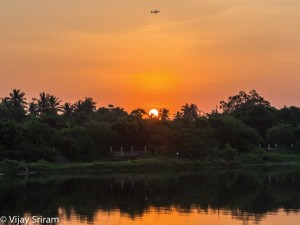Registered with the Registrar of Newspapers for India under R.N.I 53640/91
Vol. XXVI No. 13, October 16-31, 2016
Archives: Vol. XXVI No. 13, October 16-31, 2016
Mylapore for World Heritage status?
(By A Special Correspondent)
 A beautiful picture by Dr. VIJAY SRIRAM of sunset over the Adyar River – NOT seen from the aircraft above but
A beautiful picture by Dr. VIJAY SRIRAM of sunset over the Adyar River – NOT seen from the aircraft above butfrom the north bank.
The last month saw print and social media report on a city-based think tank demanding that Mylapore be given world heritage status. While this is not a tag that is given out for the asking and, so, is not likely to happen any time soon, the question is does Mylapore deserve such a status and, more importantly, can it live up to the discipline that such an accreditation demands?
If, indeed, it is the dominant presence of the temple at the heart of the locality that has spurred this suggestion, then there are several others that can compete for this even within Tamil Nadu. Take for instance the Meenakshi Amman temple in Madurai. Would that not qualify better? Or, for that matter, Srirangam? Both of these shrines have created an ecosystem around them that depend on the central attractions for survival. There is, consequently, a lot of effort on maintaining tradition. Even the commercial establishments around have realised this and are doing what little they can to participate, something that cannot be said of Mylapore. True, the temple does form a focus here as well. But there is lot more to the place than just that. There are multiple religions that claim a share in its antiquity. That again is an attribute that towns such as Nagapattinam and Trichy can lay claim to. Can Mylapore stand up to be counted?
The next question is, what exactly of its heritage has Mylapore retained? In terms of its antiquity, there is not much. Not even the present Kapaliswarar shrine or for that matter the San Thomé basilica, can claim a physical connect to a very ancient past. This is partly due to historical reasons but also in part due to rampant modernisation that has taken place within the shrines.
Lessons to learn from Kolkata
by A Special Correspondent
The Durga Puja festival in Kolkata has just come to an end. The city witnessed around 36,000 different pandals being put up, for the duration of five days, all in public places – street corners, parks and sidewalks.
These temporary structures and their contents, chiefly icons and friezes, cost a whopping Rs 600 crore in a rough estimate, making it one of the biggest religious events celebrated in public. The five-day extravaganza witnessed a huge degree of public-private partnership in making it a success and ensuring it passed off peacefully. There is much that a city like Chennai can learn from this experience.
Some oil on Cauvery waters
S. Viswanathan
The Cauvery Water dispute has a long and chequered history.
Tamil Nadu lacks a perennial river and, until 1974, the State had a lion’s share of the Cauvery waters. This was reduced when Karnataka expanded its consumption of water by constructing a number of dams and expanding its canal system. When the 50-year-long earlier agreement ended in 1974, the issue heated up. Chauvinistic attitudes of political parties in both the States and an indifferent Centre contributed to the issue smouldering for over four decades. In the absence of agreement on the part of the political leadership, the only course left was to take recourse to ajudicial remedy.
Murthy – the surfing champion
by Uma Muthuraaman
From an undistinguished boy who surfed the waves using flotsam and styrofoam boards, to becoming a champion surfboarder, Murthy Megavan has come a long way. He is at the centre of an upcoming surf school serving as a source of inspiration for aspiring surfers, trainers, community builders and humanity – lifting the lives of many, like a rising tide does.
Besant to Vasantha
by K.V.S. Krishna
“I was a student of Besant Theosophical School during 1938-50, a school Annie Besant had helped to establish.” She was greatly admired by the people of India for her contribution to the freedom movement as well as her devotion to education. She established the Vasantha Press with her own funds, outside the Theosophical Society (TS) compound, to publish her political writings as well as all the publications of the TS. She herself published some 300 books.

